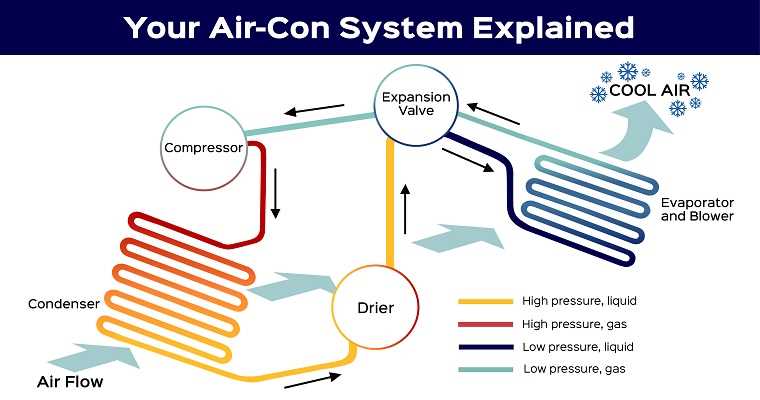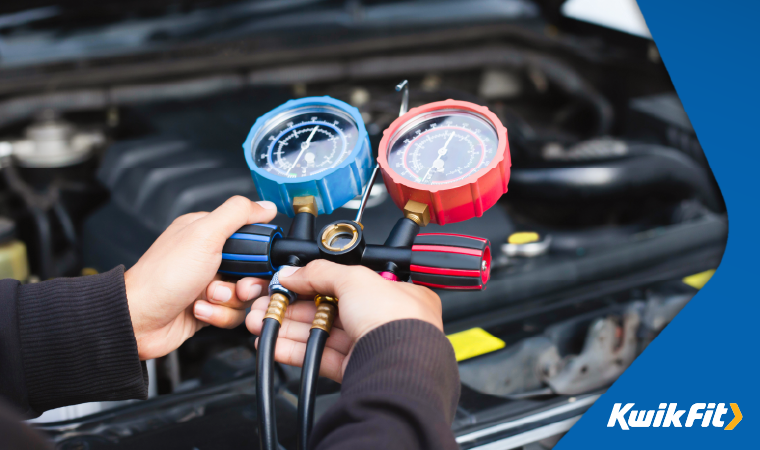Everything to Know About Maintaining & Regassing Car Air Con
Jessica Bird | Sunday 8th June 2025 10:15am

We’ve all felt the discomfort of getting into a hot car on a scorching day — and, unlike in winter, no amount of leaving-the-car-running will help the situation if your air con is broken or in need of regassing.
If you’ve ever wondered what goes on behind the vents to keep you cool, or you’re looking for tips to make the most out of your air con, you’ve come to the right place.
In this complete guide to air con, Kwik Fit’s experts cover how car air conditioning works, tips for maintenance, and everything to know about air con regassing.
How does your car's air con work?
The short answer is that in order to cool warm air down, a refrigerant gas needs to be used. Over time, the refrigerant changing state between gas and liquid means parts of it are lost through the system – so there’s less available to help cool the warm air.
Here’s the long answer:
While it may seem counterintuitive, the entire process of cooling air actually starts with compressing a gas to a high temperature, and then using its change in state to create dramatic changes in temperature. These changes in temperature are then used to cool your cabin air, remove humidity, and make for a much more pleasant summer!
The most important parts of this system are the compressor, condenser, and evaporator.
1. The compressor starts the process
When the air con is turned on, the gas in the system begins to be compressed by (you guessed it) the compressor. Now, when a gas is compressed (pressurised), its temperature will rise – the compressor’s job is to pressurise the refrigerant gas to around 85°C. At this point, the very hot, high pressure gas is sent to the condenser.
2. The condenser heats up the refrigerant
You can think of the condenser as quite similar to a household radiator (and, in fact, it’s usually what’s called ‘the radiator’ on a car): the high pressure, high temperature gas passes through the coils in the condenser, and the outside air that passes over the condenser coils cools the gas down to around 55°C.
Importantly, it’s kept at the same high pressure – and this has the effect of turning the gas into a liquid. There’s a ‘drier’ that’s part of this component and this exists to remove water from the system in order to avoid any crystallisation that could block or damage components.
At this point, the high pressure, somewhat cooler liquid is then sent to the evaporator.
3. The evaporator cools things down
At the beginning of the evaporator is an ‘expansion valve’ – put simply, this behaves in much the same way as the nozzle of a spray can. By creating a very small hole through which the high pressure liquid can pass quickly into a much lower pressure area, the liquid cools suddenly while turning back into a gas.
It cools to a temperature of around 0°C (which is not freezing point for the gas, remember) and this now-cool gas passes through the evaporator. As it’s passed through the evaporator coils, a blower takes air from inside the vehicle and blows it over the cold coils and into the cabin. The low pressure gas then goes back into the compressor to start the process again and, like magic, you have cool air to make your summer drive bearable.

This is almost entirely a closed-loop system – but the drier has the effect of removing parts of refrigerant that didn’t turn into a liquid properly as well as removing any accumulated water. So, over time, the system runs out of refrigerant and needs to be topped up.
Understanding your air con controls and vents
If you’ve just bought a new car or are just looking at your air con system closely for the first time, you might be wondering, “What does that button do?”. Air conditioning systems aren’t difficult to use, but there are plenty of ways to maximise their usage and use the settings to your advantage.
Here’s a quick guide to some of the most common settings and buttons on a car’s AC system.
Adjusting your air con vents for maximum airflow
To make sure you and your passengers enjoy maximum comfort on hot, sunny days, here are some air con vent adjustment tips you might want to make a note of:
- Concentrate the flow of cool air where you want it by closing any unused vents (especially in the back of the car if you’ve not got passengers).
- Avoid pointing any vents directly at windows unless you’re trying to demist them on a cooler day.
- To keep cool — but not flustered — direct vents towards your chest and body, but avoid the face. A strong stream of air blowing directly into your eyes could be a distraction when driving.
Fresh air versus recirculation: what's the difference?
Your air con system will likely have a slider to toggle between fresh air in and recirculating air in the cabin. During longer drives or in cooler weather, the fresh air setting is best to use to keep your cabin air healthy and cold.
Recirculation, on the other hand, is better used when you want to keep warm air (or fumes) out of the cabin. If using the recirculation setting, don’t leave it on for too long or your cabin air might start to feel stuffy.
Why does your car's air con reduce in performance?
If your air conditioning starts blowing warm air or doesn’t feel as effective as it used to, it’s probably time for a recharge. But why does this drop in performance happen in the first place?
Leaks
Your air con relies on a steady flow of refrigerant around its system to successfully cool down the air in your cabin. However, over time, this gas can leak out of the system, gradually reducing the effectiveness of your car’s air conditioning.
Natural wear and tear & lack of use
The components within your air conditioning system (such as hoses and seals made from rubber) can dry out or even crack over time, making them less effective at keeping refrigerant contained. This is especially true if you don’t use your air con system a lot.
If your air con is blowing out nothing but hot air, diagnose the issue with help from our guide, “Why Is Your Car’s Air Con Not Cold?” or our expert technicians.

How to look after your car's air conditioning?
Like all aspects of a vehicle, the air con system is one that, over time, needs servicing. There are moving parts, filters, fans, and coolant gas that all need to be checked, cleaned, and topped up.
Moreover, leaving the systems unused for extended periods of time can also cause them to rust and become unusable – thus leading to more expensive replacement costs further down the line.
There are also air filters within the system that can get blocked or breed mould – making for a very unpleasant, if not harmful, experience.
Test-run your air con regularly
If you haven’t used your air con for a while, give it a good test run every once in a while to make sure it’s still blowing cold. We recommend running your air con for about ten minutes every week on the coolest setting to clear out any dust and dirt.
Use your air con in the winter
Yes, really. Your air con can — and should — be used year-round to keep it running and to make your life easier on cold mornings when your windscreen needs demisting.
Your air conditioning helps clear fog and ice from your windscreen by reducing the humidity levels in the vehicle. We’ve got an entire guide on using your air con in the winter, if you were curious.
Change the cabin filter regularly
If your cabin filter is clogged, it can reduce air flow and have a detrimental effect on how well your air con is working. Replacing this crucial filter is a surefire way to keep the air inside your cabin clean, fresh, and cool.
We recommend changing your cabin filter every 30,000 miles to remove the natural build-up of dust and debris in your car’s air con filter. Failure to do so may lead to the emission of foul odours from your vents as mildew gathers there.
Get an air con regas or "recharge"
Recharging (or “regassing”) your air con with refrigerant restores its cooling power. We recommend that you get your air con regassed every 2 years in the interest of improved performance and fuel economy.
The benefits of an air con regas
Naturally, regassing your air con means you can keep the air inside your car cool— but there are some other reasons to do so that you may not expect.
- Recharging prevents warm air from catching you off guard in the summer.
- A regas helps your system run efficiently and use less fuel.
- Air con clears foggy windows quickly in cold or damp weather.
- Regular regassing protects key parts, like the compressor, from damage.
- Skipping recharges can lead to costly air con repairs down the line.
- A well-maintained system can help maintain your car’s resale value.
For more detail about the benefits of getting your air conditioning recharged, read through our blog titled, ‘Why It's Time To Get Your Air Con Recharged’ before booking a regas at your local Kwik Fit today.
Is an air con regas part of a major service or MOT?
No, your annual MOT ensures the vehicle is safe to drive as per strict DVSA guidelines. Since air conditioning is considered a ‘nice-to-have’ feature and is not critical to the vehicle's safe running, your MOT tester will not check to see if your air conditioning is working.
Similarly, air con is not included in the standard service schedule set out by your vehicle manufacturer. Regular servicing will help keep your car running for longer in a safe and reliable condition and includes some replacement parts like the oil and air filters.
Can I regas my air con myself?
While it is possible to purchase kits online that claim to help drivers regas their air con systems themselves, we strongly advise against it. An air con regas involves pressurised refrigerant, hazardous substances, and technical equipment, so it’s better left to the professionals. If your system is regassed wrong, you might encounter a leak, which could result in costly repairs.
To find out more about taking good care of your air con, read our blog titled “Maintaining Your Car’s Air Conditioning”.

Keep your cabin cool with Kwik Fit's air con services
At Kwik Fit, we offer a complete air conditioning recharge service at over 600 centres nationwide. We also offer a “Recharge or No Charge” guarantee should we find a leak in your air con system and the recharge cannot be completed.
If we can’t improve the coolest vent temperature in your vehicle by more than 10% when measured in degrees celsius, then we will happily refund you the price of your recharge. Our centre staff can also help to diagnose problems with your air con system should your system not hold its charge.
Book your air con recharge online or discover more air con tips on the Kwik Fit blog. Got any questions? Give us a call.
Any facts, figures and prices shown in our blog articles are correct at time of publication.
Featured Articles
Is it Illegal to Drive With One Headlight?
Saturday 19th July 2025
Wondering if it’s illegal to drive with one headlight? Learn about the safety risks and penalties of illegal blown bulbs and why you should fix them promptly.
Air Con in EVs & Hybrids: Experts Answer Your Questions
Monday 30th June 2025
Does air con drain EV batteries? Can you use the air con while charging an electric car? Find out the answers to these questions & more from Kwik Fit’s experts.
Why Is Your Car Making a Noise? Fixes & Tips
Friday 13th June 2025
When your car starts making unexpected noises, it can certainly be quite disconcerting; it may be nothing to worry about, but here’s what you need to know.









